

james lewis
Do We Really Have High Expectations for All Students? By Barbara Blackburn Do you have high expectations for your students?
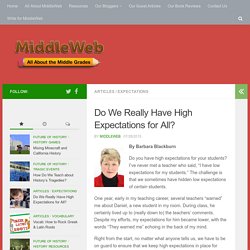
I’ve never met a teacher who said, “I have low expectations for my students.” The challenge is that we sometimes have hidden low expectations of certain students. 38 Question Starters based on Bloom’s Taxonomy - Curriculet. Curriculet is free for teachers and students.
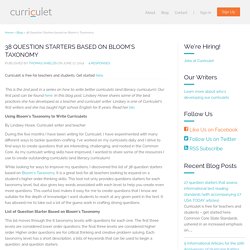
Get started here. This is the 2nd post in a series on how to write better curriculets (and literacy curriculum). Our first post can be found here. In this blog post, Lindsey Howe shares some of the best practices she has developed as a teacher and curriculet writer. Blooms%20Taxonomy%20questions.pdf. Handling Difficult Students The First Week Of School. Hoping to head misbehavior off before it starts, most teachers try to be proactive with difficult students.
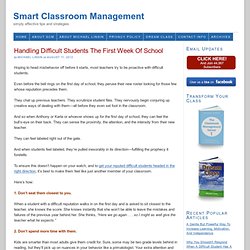
Even before the bell rings on the first day of school, they peruse their new roster looking for those few whose reputation precedes them. They chat up previous teachers. They scrutinize student files. They nervously begin conjuring up creative ways of dealing with them—all before they even set foot in the classroom. And so when Anthony or Karla or whoever shows up for the first day of school, they can feel the bull’s-eye on their back.
They can feel labeled right out of the gate. And when students feel labeled, they’re pulled inexorably in its direction—fulfilling the prophecy it foretells. How To Handle Misbehavior The First Two Weeks Of School. Your new students will likely be on their best behavior for the first few days of school.

But by the second week, you and your classroom management plan will be tested. After all, your students don’t really know you. Maybe you’ll be like the pushover teacher they had last year. Maybe you’ll be inconsistent or easy to fluster. Maybe you won’t really mean what you say. Fostering Relationships in the Classroom. Students and teacher need to develop positive and trusting relationships in an effective classroom.

It is also critical that all students, especially English-language learners, develop trusting and enriching relationships with each other. There are many activities which can be used for both introductory purposes and throughout the year to build and maintain positive relationships in the classroom. Some activities which work well to introduce students to each other and to the teacher can be used again at later points in the year as students' interests change and as they gain new life experiences. 7 First Day of School Activities Students Love. The first day of school will be here before you know it.
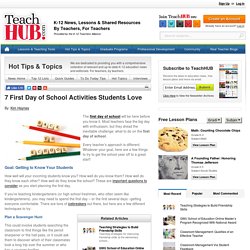
Most teachers face the big day with enthusiasm, but they dread the inevitable challenge: what to do on the first day of school. Every teacher’s approach is different. Icebreakers _word doc._.doc. A Classroom Management Strategy For The First Days Of School. At the start of a new school year, it’s common for teachers to send home a packet of information for parents.
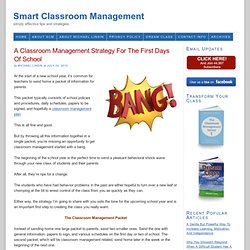
This packet typically consists of school policies and procedures, daily schedules, papers to be signed, and hopefully a classroom management plan. This is all fine and good. 'Most Likely To Succeed': Schools Should Teach Kids To Think, Not Memorize. Students Tell All: What It’s Like to Be Trusted Partners in Learning. Inquiry-based learning is not a new pedagogy, but it has come back into fashion in progressive education circles recently because of new emphasis on the power of students’ innate curiosity to drive learning.
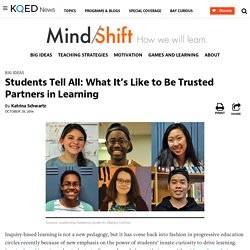
Inquiry-based learning asks students to discover knowledge on their own with guidance from their teachers. Rather than receiving information up front through lectures, students research guiding questions, ask their own follow-ups and get help along the way. Learning through inquiry requires more student agency and demands that teachers and administrators trust that students will ask when they need help. It also places the responsibility for completing tasks and meeting deadlines on the shoulders of students. Science Leadership Academy (SLA) in Philadelphia is a partnership between The School District of Philadelphia and The Franklin Institute. Science Leadership Academy students spoke about their learning experience at the school. 5 Powerful Questions Teachers Can Ask Students.
My first year teaching a literacy coach came to observe my classroom.

After the students left, she commented on how I asked the whole class a question, would wait just a few seconds, and then answer it myself. "It's cute," she added. Um, I don't think she thought it was so cute. I think she was treading lightly on the ever-so shaky ego of a brand-new teacher while still giving me some very necessary feedback. So that day, I learned about wait/think time. Smart Strategies That Help Students Learn How to Learn. Teaching Strategies Bruce Guenter What’s the key to effective learning?
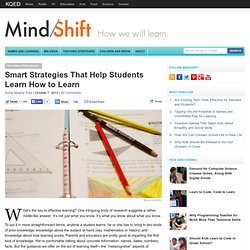
One intriguing body of research suggests a rather riddle-like answer: It’s not just what you know. It’s what you know about what you know. Ten Takeaway Tips for Teaching Critical Thinking. Suggestions from educators at KIPP King Collegiate High School on how to help develop and assess critical-thinking skills in your students. Ideally, teaching kids how to think critically becomes an integral part of your approach, no matter what subject you teach.
But if you're just getting started, here are some concrete ways you can begin leveraging your students' critical-thinking skills in the classroom and beyond. 1. Questions, questions, questions. Questioning is at the heart of critical thinking, so you want to create an environment where intellectual curiosity is fostered and questions are encouraged. In the beginning stages, you may be doing most of the asking to show your students the types of questions that will lead to higher-level thinking and understanding. 2. 50+ Tools for Differentiating Instruction Through Social Media.
Imagine a world where resources were limited to what was found in the classroom or the school closet known as the "Curriculum Materials Room. " Picture a world where students wrote letters with pen and paper to communicate with other students and adults outside of the building. Due to postage costs, the teacher either sent the letters in bulk or paid for stamps out of his or her own pocket. Can you recall a time when student interests like skateboarding or video were never used as part of learning curriculum because the tools needed were either too expensive or not yet conceptualized? Helping Diverse Learners Succeed. My career got off to a bad start when I was hired to teach in a Minneapolis Ojibwe Survival School. That was the year that Prince's Sign O the Times dropped -- the year most of my lesson plans failed. More terrifying was the fact that I had no backup plan. I'm embarrassed now to admit that I sent over 15 kids to in-school suspension in a single morning.
A chair was thrown at my head and later a waterfowl-sized stone. At a school event, a masked student threatened me with a hunting knife while I stood at a public urinal. Are Teachers of Tomorrow Prepared to Use Innovative Tech? Getty Images With a new generation of teachers coming into the work force, there’s a discrepancy between what principals expect of teachers-in-training and what they’re actually learning in school.
A new Project Tomorrow report surveying principals concluded that they want to hire new teachers with creative ideas about how technology can be leveraged to create authentic and differentiated learning experiences. But student-teachers report that their tech training focuses only on simple management tools. At the same time, the report concludes that those who have the biggest influence on new teachers — veteran educators — don’t always embrace new ways of using technology to engage students. Technological Tools for Differentiated Instruction. A Teacher's Guide to Differentiating Instruction.
Introduction Does effectively teaching 30 students in one classroom require teachers to develop 30 lessons, one tailor-made for each student? Or should teachers “aim for the middle” and hope to reach most students in a given lesson? The answer is not simple. While most would agree it is impractical to try to individualize every lesson for every child, research has shown that teaching to the middle is ineffective.
It ignores the needs of advanced students, often leaving them unchallenged and bored, while it intimidates and confuses lower functioning learners. Empowering Student Relationships With Media. Debates over children and media use are nothing new, but the technologies by which children primarily interact with media have changed significantly. Most guidelines related to "screen time" were developed when television was the dominant media, but new technologies are making us question the value of older research.
In its most recent report on the subject, the American Academy of Pediatrics makes reference to "important positive and prosocial effects of media use," and a call for expanding media education programs in schools. While more dedicated media education in schools would be great, it is little more than a pipe dream in the current climate of low budgets and high-stake tests. Edutopia. I remember how, as a new teacher, I would attend a professional development and feel inundated with new strategies. 25 Ways to Develop 21st Century Thinkers. The need to develop critical thinkers has never been as urgent as it is now.